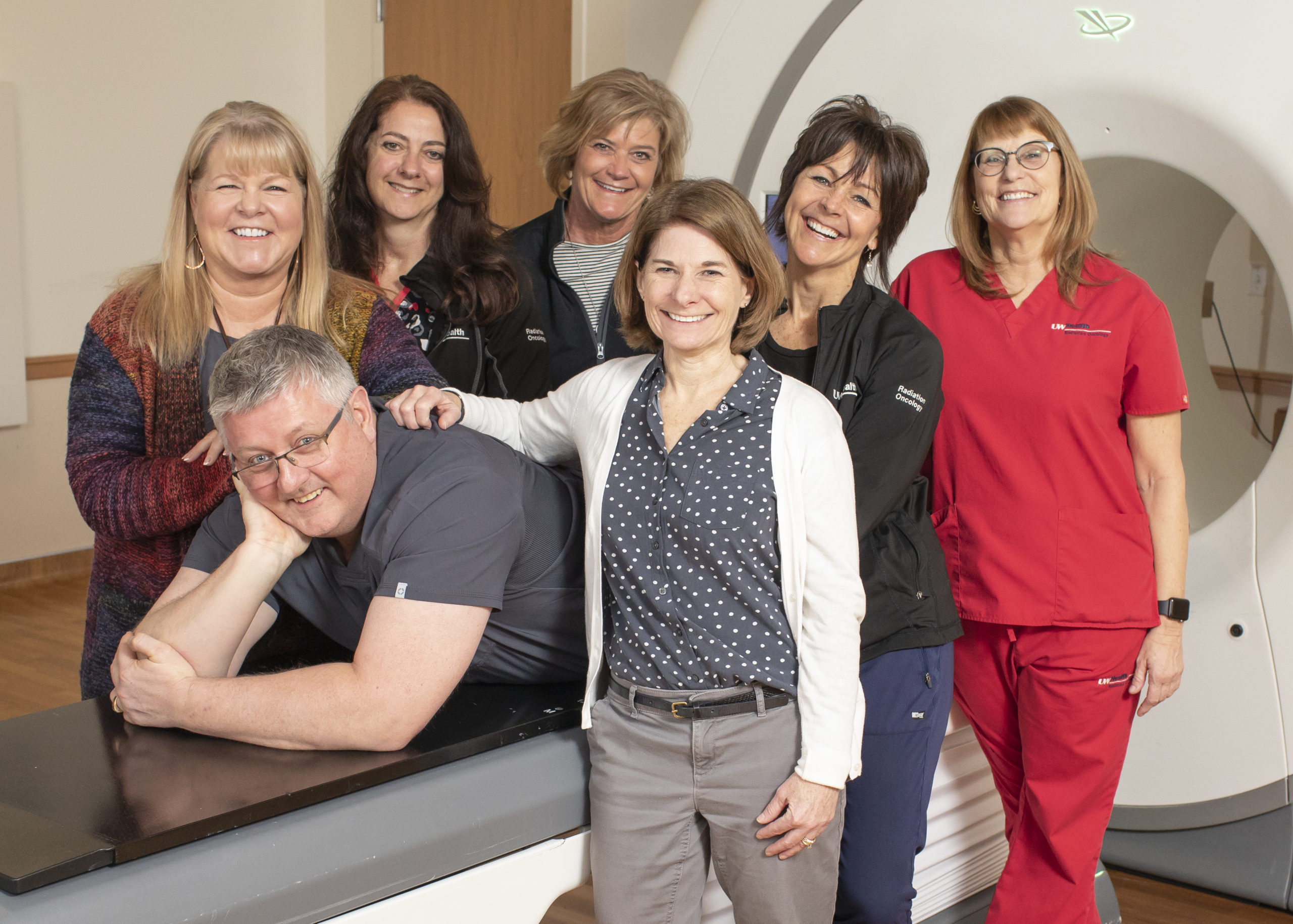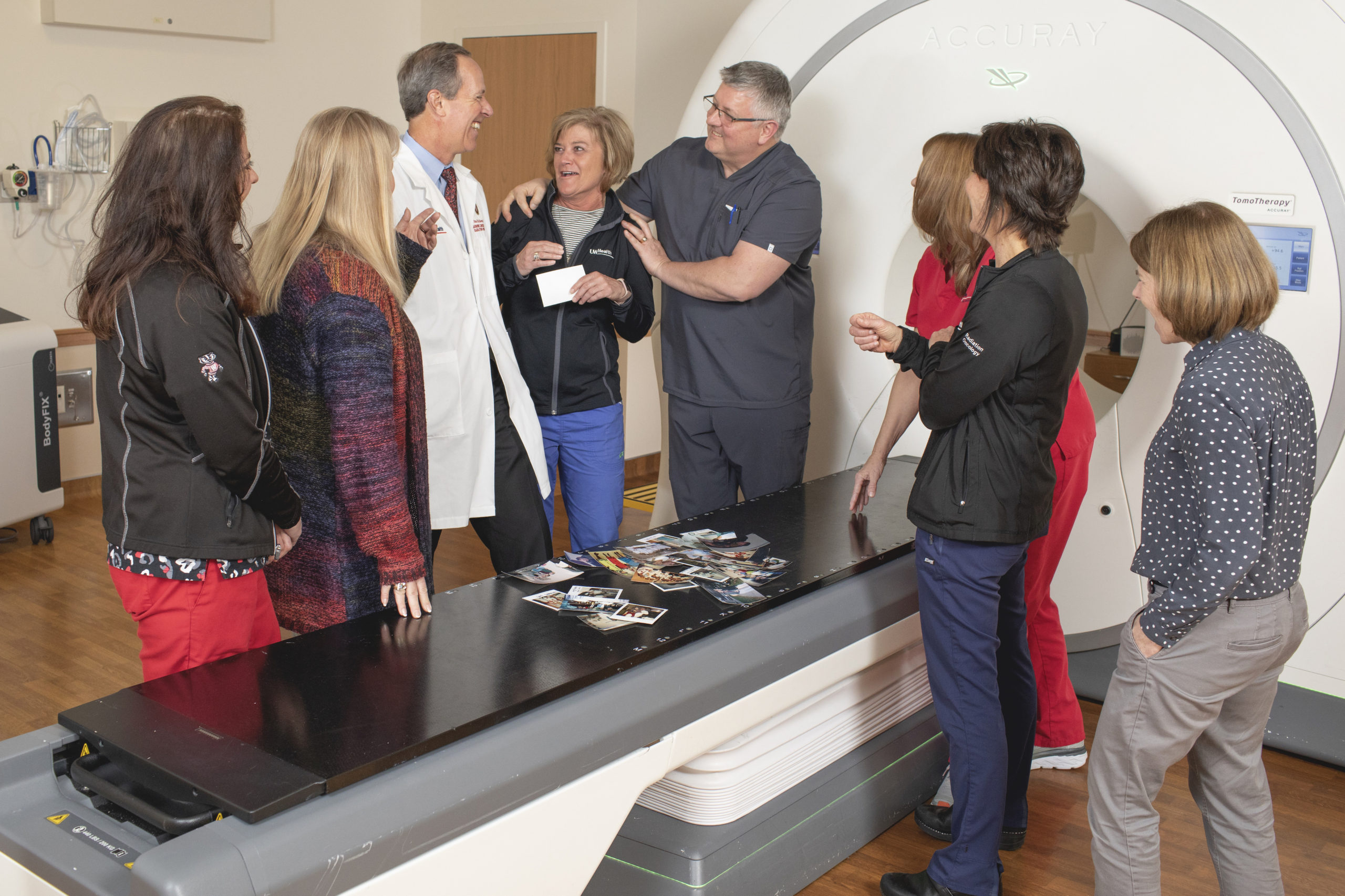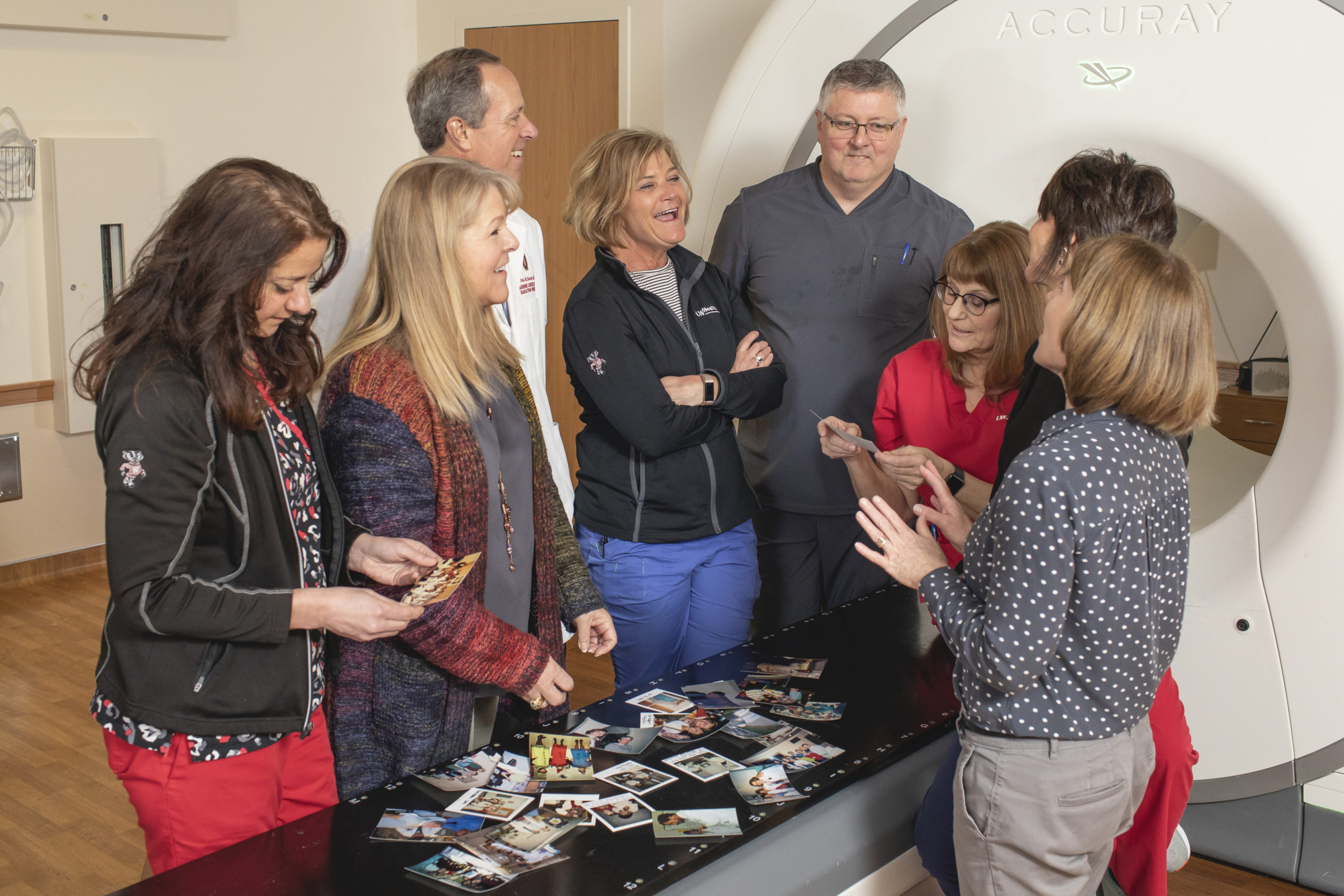
For the past 30 years, a core group of radiation therapists has been a consistent and reassuring presence in the UW Health Radiation Oncology Clinic. With their technical expertise, problem-solving abilities, teamwork, dedication, and compassion, they have benefited thousands of patients and fostered a supportive and welcoming culture for patients, families and co-workers.
A calling
Each of these therapists — Melodie Corcoran, Dan Steinhoff, Theresa Breunig, Cathy McMahon, Lisa Rindy, Lori Schmitz, Eric Wevley, and Mary Fink — was drawn to the profession for the unique opportunity afforded by the field to treat patients over an extended period of time – in most cases five days a week for multiple weeks.
“It’s a calling, not simply a job,” says Melodie Corcoran, the most senior radiation therapist. “To be present for patients in their most vulnerable and frightening time, to be part of the team that treats the person, not just the disease — this is what keeps us coming back.”
Dan Steinhoff, lead radiation therapist who got his start in the clinic in 1987, says, “It’s a job I absolutely love. It’s coming to work to see the patients. It’s knowing that I’m making a really big difference on a daily basis and making patients feel like they’re not just coming in for their appointments, but that they’re among friends.”
A welcoming environment
The radiation therapists create a supportive and welcoming environment by being upbeat and lighthearted while still being empathetic and listening and addressing patients’ concerns and needs. “We’re not quite all business,” says Lisa Rindy, a radiation therapist since 1989. “It’s calming for patients just to have a normal conversation.”
The radiation therapists often use humor and sometimes good-natured ribbing to relieve patients’ stress. For example, Steinhoff might jokingly tell Cubs fans that he can’t treat them. “I don’t put a safety bubble around patients,” he says. “They are not off limits to me giving them a hard time. They don’t want to feel like they’re the cancer patient. They usually want to be treated like anybody else.”
Like family
The positive attitude and sense of humor carries over to interactions among colleagues. They’re a close-knit group — with some of the minor annoyances, inside jokes and level of comfort with each other you’d find among family members. They have bonded over challenges in the clinic, shared experiences inside and outside of work as well as personal challenges that each has faced at one time or another.
“I would say we are very family-like. We get along nearly all the time, but we’ve had our arguments – each of us expressing our opinions about what’s best for the patient,” Steinhoff says. “Sometimes things may get a little heated, but just like a brother or sister, once it’s over, we move on.”

An essential part of the treatment team
The culture in the clinic is one of mutual admiration and respect across all members of the treatment team.
“We’ve always had this mentality that if someone needs our help, we just go and help them whether or not it’s part of our job description,” says Cathy McMahon, who has been a radiation therapist in the clinic since 1987. “If a nurse is taking care of patients, and we see they need a hand, we’ll ask, ‘What do you need?’ It’s an attitude that has been passed down. It’s just a great group of people all the way around.”
Their experience and regular contact with patients every day during treatment give them an invaluable perspective that the radiation oncology physician can count on.
“These radiation therapists are super-talented, very likeable, and knowledgeable professionals,” says Dr. Paul Harari, chair of the Department of Human Oncology and UW Health radiation oncologist. “They’re incredibly good at what they do. I’ve been at this for 30 years, and I continue to rely on them for information that that will help in a patient’s total care. In addition to letting me know how patients are doing day to day, I often rely on their feedback and experience to help determine whether or not a given treatment plan is realistic for a particular patient.”
That same experience also informs treatment plans. Mary Fink, who began as a radiation therapist in 1988, now serves a dosimetrist, creating treatment plans. “I enjoy the challenge of putting together treatment plans and help to spare normal tissue while delivering higher doses and giving patients a higher quality of life. My experience as a therapist has been a huge positive. It has helped me know what patients can tolerate.”
Growing with the profession
When these radiation therapists started their careers, the technology was well-established, and the role had been fairly stable. The radiation therapy machines were controlled manually. Imaging was done with X-rays that needed to be developed in a darkroom down the hall. Heavy blocks needed to be placed in the machine to shape the beam. And there was nary a computer to be seen.
In the 1990s and 2000s, new technologies brought unprecedented changes that transformed the clinic and made the role of radiation therapist less physically demanding but much more complex and intellectually demanding. These therapists were part of the transition from manual control to computerized control of treatment machines, from hand blocks to multileaf collimators, from X-rays to instantaneous CT imaging, and other advances that have enabled better treatments. With the new technologies came new techniques to learn, and they rose to the challenge.
“The field has always kept us on our toes,” McMahon says. “It’s ever-changing. None of us is ever bored or feel like we’re getting stagnant. We’re always challenged.”
“We’re lucky here. We’re consistently among the first to get the new technologies,” says Lori Schmitz, who started as a radiation therapist in 1991 and now does medical coding and billing in the clinic. “Each of us has taken turns learning new procedures and then we teach the others.”
Grateful patients
The therapists’ expertise and the culture they foster contributes to high patient satisfaction. The clinic is consistently among the highest rated in the entire UW system.
“Having these great therapists really impacts the patient experience and that is evident in the patient evaluations,” Dr. Harari says. “I’ve said many times that we ride on the radiation therapists’ coattails when it comes to patient surveys. When patients tell us everything about their treatment was amazing and the people are so nice, we are benefiting from the fact that we have amazingly good therapists who are with the patient every day and develop personal relationships.”

A lasting legacy
The therapists touch patients’ lives and vice versa. Visits, phone calls, treats, chance encounters in the community, and thank-you cards from appreciative patients are remarkably common as reminders of the lasting impact of their work.
A recent patient card reads: “I really appreciate the kindness and professionalism you each showed me as I went through my radiation treatments. All of you do such great work.”
Another patient wrote: “You are the best. You will all be in my heart forever.”
Their commitment to patients and to promoting a workplace culture that supports patients and co-workers alike will be part of the legacy passed forward through training students enrolled in the radiation therapy program. Mentoring these young co-workers strengthens the culture of patient care excellence for the future that is so meaningful to cancer patients.
“One aspect we model to students is how to visit with and enjoy your patients and really get to know them,” says Theresa Breunig, who has been a radiation therapist in the clinic since 1989. “I was the quiet kid coming in. I didn’t say a whole lot and would rely on more experienced colleagues to talk with the patients. Now, I’m the more experienced therapist, and the younger generation is learning this skill from me.”